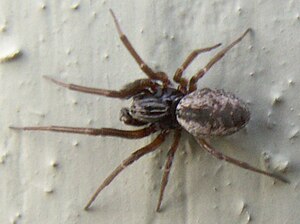Common curly spider
| Common curly spider | ||||||||||
|---|---|---|---|---|---|---|---|---|---|---|

Common curly spider |
||||||||||
| Systematics | ||||||||||
|
||||||||||
| Scientific name | ||||||||||
| Dictyna arundinacea | ||||||||||
| ( Linnaeus , 1758) |
The common or common curling spider ( Dictyna arundinacea ), also called meadow lurking spider , is a web spider within the family of curling spiders (Dictynidae). It is the type of the genus Dictyna and therefore of the entire family. The common German name Common Curling Spider suggests that this spider is one of the most common types of curling spiders.
features
The body length of the common curly spider is 2 to 3 millimeters in males and 2.5 to 4.5 millimeters in females. The entire body is dark brown and covered with whitish gray and brown hair. The hairs create a characteristic pattern on the back of the body (opisthosoma), the front section of which consists of a dark, elongated spot that usually appears constricted in the middle. This is followed by several crossbars or angular spots that become shorter towards the rear. The first of these crossbars usually has characteristic, forward-pointing tips at its ends. This drawing can appear washed out in older specimens because of the abrasion of the hairs.
The legs are dark brown, with indistinct, light or dark ringlets in places. The underside of the coxen and thighs are covered with white hairs. The tips of the tarsi are dark in color. The cribellum As with all members of the genus Dictyna undivided, which makes this, for example, from other genres of dictynidae Nigma differ.
Similar species
The common curly spider can be confused with other species of the same genus, for example with the hedgehog spider ( Dictyna uncinata ). However, this only has three instead of five stripes of hair on the front body . Dictyna pusilla is significantly smaller than the common curly spider. The surest method of differentiation is a microscopic examination of the genital organs.
Occurrence
The common curly spider is found in almost the entire Holarctic , it can be found in Europe , Asia and North America . It seems to be missing only in India and Southeast Asia . In most of the regions in its range it is the most common cribellate spider . The species lives in sunny and open places, for example heather and roadsides, as well as wet meadows and dry grasslands .
Way of life
The common curled spider prefers to build its irregular net at the top of dead plants from the previous year, such as common heather , St. John's wort or Dost , which protrude from the surrounding vegetation . About in the middle, usually at a branch of the plant, the spider builds its central and thicker spun hiding place and from there weaves loose catch threads leading outwards. Viewed in its entirety, the web is reminiscent of that of the crested web spiders . In contrast to these, however, the catch threads surrounded with crimped wool serve to hold the prey instead of glue droplets. With the calamistrum , a comb-like structure on the metatarsus of the last pair of legs, the crimped threads produced by the cribellum are combed onto the catch threads. The insects flying into the net get caught in the fishing wool. The alarmed spider paralyzes them by means of poison, even if they are much larger than them.
The spider itself usually hides in its hiding place. She also deposits her lenticular, white egg cocoons here . Four to six such clutches can be produced per year. The females can be observed from March until late autumn, the males until August. The main mating season is in summer in mid- latitudes and earlier in the south. The males die soon after mating, their lifespan after moulting is very short.
Individual evidence
- ^ Dictyna arundinacea. In: World Spider Catalog. Version 16, Natural History Museum Bern, 2015, accessed on May 28, 2015
- ↑ a b W. Nentwig, T. Blick, D. Gloor, A. Hänggi, C. Kropf: Dictyna arundinacea. Description and distribution map at araneae - Spiders of Europe, Version 05.2015, accessed on May 28, 2015
- ↑ a b Heiko Bellman: The cosmos spider guide. Over 400 species in Europe. Kosmos nature guide. Kosmos (Franckh-Kosmos), 1st edition, Stuttgart 2010, p. 216 ISBN 978-3-440-10114-8
- ↑ a b c d e Nicolaj Klapkarek: Wiesenlauerspinne - Dictyna arundinacea species profile at www.natur-in-nrw.de, accessed on May 28, 2015
- ^ A b Heiko Bellman: Cosmos Atlas Arachnids of Europe. Over 1000 photos. Kosmos (Franckh-Kosmos), 3rd edition, Stuttgart 2006, p. 42 ISBN 978-3-440-10746-1
literature
- Heiko Bellman: The cosmos spider guide. Over 400 species in Europe. Kosmos Naturführer, Kosmos (Franckh-Kosmos), 1st edition, Stuttgart 2010, p. 216 ISBN 978-3-440-10114-8
- Carl von Linné : Systema naturae per regna tria naturae, secundum classes, ordines, genera, species cum characteribus differentiis, synonymis, locis. Editio decima, reformata. Araneae, pp. 619–624, Stockholm 1758 (first description)
Web links
- Dictyna arundinacea. In: World Spider Catalog. Version 16, Natural History Museum Bern, 2015, accessed on May 28, 2015
- W. Nentwig, T. Blick, D. Gloor, A. Hänggi, C. Kropf: Dictyna arundinacea. Description and distribution map at araneae - Spiders of Europe, Version 05.2015, accessed on May 28, 2015